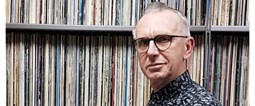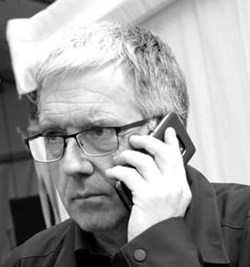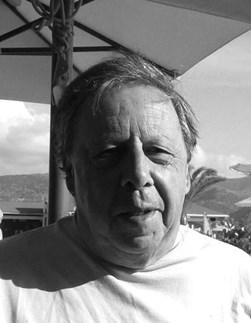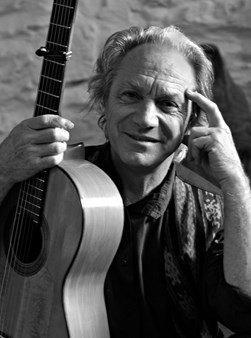ENJOY JAZZ 2025 - October 17 - 20

Four days at places of the 7-week festival stretch of ENJOY JAZZ: Schwetzingen (Barocktheater), Heidelberg (pop-up venue next to the festival’s HQ), Ludwigshafen (Das Haus), three neighboring places in the Rhine-Main area in two neigboring federal states of Germany, Baden-Württemberg and Rhineland-Palatinate. It sounds complex and colorful. To learn more you can consult the festival’s website for the still coming concerts. Here is my review of the short slice of the long sequence of autumnal concerts.
You can experience different kinds of concerts: concerts of (a) highly estimated musicians that perform up to your expectations or even exceed those , (b) concerts of new musicians on the scene that are surprising, overwhelming, astonishing, promising, innovative etc., (c) concerts of highly estimated musicians that do not work out up to your expectations or even disappoint and (d) concerts that leave you more or less indifferent. I attended five concerts: two of the (a)-category, one of the (b)-category, one of the (c)-category and one of the (d)-category. The vocal part was quite high related to the piano- and saxophone part. [bass, only one!]
MICHAEL WOLLNY solo


I know pianist Michael Wollny from his very beginning and saw, met him several times in the earlier days of his beautiful career with his trio and organised an unforgettable colorful solo-concert of him in Amsterdam. I was curious to see what of his unique spirit still retained its original charisma and how it had matured.
Wollny let the tones dance, and at just the right moment, he transformed the choreography into a shadowy, expressive scene that his listeners cannot and do not want to escape. In the foreground, perhaps, there was pianistic bravura and harmonic tripping. But behind it, in between, below, and above, shadowy spirits started to roam, shadowy spirits that shine into other enchanted realms.


Swapped sides, sudden turns, flickering light effects, tense gazes, mysterious flitting … evoking associations with Balinese Wajang plays (he would be an ideal musical accompanist). His listeners were too happy to be led and seduced by (t)his game. The music realized itself in a lively, intimate relationship between both. The original Wollny spirit was (still) there in full bloom.
SOAP & SKIN
The Viennese Anja Plaschg constellation under the moniker Soap&Skin stood in first place out through its excessive technical production efforts concerning sound and light. Plaschg sitting in front of a cabled upright piano with her back to the audience accompanied her short songs - often covers of iconic rock-/pop songs as “The End” (The Doors) - highly concentrated herself, at certain moments backed by a small massively amplified ensemble of trumpet, bass clarinet/bass drum, violin and cello. This massive magnification had an impressive effect in the beginning but in the long run the inner relationship with Plaschg’s personality and the character of the songs - as in Björk- or Annie Lenox shows - was lacking. Or better said: I was missing it. The audience was drawn by the massiveness but a thrilling, infectious interaction did not really occur. Ultimately, despite its might, it remained - with a few exceptions - well-kept streamlined, highly mass media suitable.
That doesn't change the fact that her approach - she fills big halls - apparently gets under the skin for younger generations. This might be an effect of the combination of smooth, clean, mighty instrumental lines and her straight-forward, forceful determined vocals. She does not overwhelm but gives her voice transparently to her young(er) audience. The contrast with the solo concert the next morning at the matinee could not have been greater.
CAMILA NEBBIA solo



Camila Nebbia is a fenómeno extraordinario en múltiples aspectos: as a instrumentalist especially on tenor saxophone, as a musician in general and as a radical artist in the media of sound, vision and word.
When she intones her main instrument, the tenor saxophone, after a few measures it’s completely clear that she is a master of the instrument on which she goes for uncompromising expressivity. Which means she goes for the furthest possibilities the instrument offers, for its full expressive load. Not in a impression making mode but in a full coalition of her expressive needs, ideas and feelings and the potentials of her instrument.
Her forceful versatility is immediately drawing listeners in. The convincing cohesiveness of her progression is increasing and heightening that immediate effect. She continues fearlessly clearly attracted by a next zone feeling as a necessary consequence. Tension, astonishment, offence, release and joy merge in extraordinary multiple ways for her listeners that she leads through a wild garden as antidote to everyday life chaotic and burning areas. No beautified perfect world but the antidote in realms of wilderness. As such it is also echoing our states of mind with confused, perfused, transfused, skipping, (un)soothing feelings. Her playing, her art is carried by a lively, strongly transporting inner rhythm connecting us.



It’s never a 1-1 relating thing but a passage constantly balancing on the edge of shifting, crashing, crunching tonalities, loud as well as whispering, violent as bold, courageous as gentle. It leaves behind artistic experimentalism and enters, touches on real life ambiguities.
I saw her performing before in group-constellations where she struck me with the same force and left behind indelible, long-lasting traces. For me she is - a.o. beside Sakina Abdou, Sun-Mi Hong and Marta Warelis - one of the hottest burning spears of this moment's upcoming musicians.
LA KULJICA


in sharp cadenza and soft flights with Kalima’s Kalle, Reznichenko’s Olga, Lillinger’s Christian, Dahl’s Tim at ENJOY JAZZ, Das Haus, Ludwigshafen Jelena Kulic’s intoning poetry of ex-Yugo writers were a promising thing I was looking forward very much after having experienced a lot of thrilling performances with her in the groups Kuu and especially Frank Gratkowski’s Z-Country Paradise in the past.

The band played edgy and La Kuljica delivered her great Sprechgesang in multifarious tones but for me it didn’t catch fire or smouldered in catching manner. Maybe my expectation was in my way during the concert to really get on the train in spite of some flaring moments.
SIMIN TANDER QUARTET THE WIND


It is not that easy to write after such a forceful concert, a concert that felt as 90 intense minutes of elegantly whirling, truly soul music, a concert that left behind deep personal footprints of the leader and characteristics of all four musicians from which a closely knit, unified group and music emerged, a concert whose dynamics were dense, completely coherent and intertwining to a high degree in in its up- and downswings. It actually was a concert that satisfied in high degree my secret wishes and my wishful demands to music making in general.
The winds’ voices
The central image of the music was ‘the wind’ as a binding, merging and shaking up and redistributing force. The wind, this hearable force, is our permanent accompanist. When it cannot be sensed, it’s a sign of something is wrong. But the wind has no voice itself. What we hear, are the sounds caused when air currents encounter resistance, rub against it, make it vibrate, whistle, howl or crack. And these induced noises can be amplified by increasing air currents themselves.
Combination - permeation - transition or how to arrive at (your very own) voice articulating present time


Guided by this internalized image and principle of ‘the wind’, Simin Tander and her musicians again and again created infectious combinations, efficacious permeations and bold transitions all in changing tempos and outpouring of various temperaments and moods. In the concert Tander exposed her voice to a greater variety of modalities activating her multifarious potentials. It is clearly not in first place a stylistic question. It is more a means to reach a certain level of significant expressive power. She and the group, violinist Harpreet Bansal with her infectious flags and subliminal echoes, guitarist Björn Meyer with his clear rhythmical tonal guidance and percussion spirit Samuel Rohrer from great depths carrying them in(to) the vastness of space, created a lot of momentum that always felt as resulting from the groundwork of the group and as emerging from the close communality and confluence in their performance. In this dramatic process time after time Tander realized her very own voice, become one with the colours of her very own inner voice. It enhanced her and the groups’ credibility, persuasiveness and true soul motion. Arriving at this point, means that they had transformed the ‘old’ songs and lyrics into one of our present time breath’s transcendence.


Reaching expressive freedom and waiting for the dark low voice
Tander and also the group arrived at a point of bringing expressive freedom into action. It was not a question of surpassing limits or lines. It became a matter of more easily find and realise the right, apt form of expression in the moment. That is not in first place a stylistic question. It is more a means to reach certain climaxes and a high level of freedom in expression. In splendid interactions of fantastic violinist Harpreet Bansal, Björn Meyer on his six-string bass guitar realizing a great fusion of guitar and bass, and Samual Rohrer on his sophisticatedly muted and expanded drums created music of orchestral character of great intimacy. After experiencing a lot of vocal qualities I got more and more curious to hear the deep dark voice in all its contrasts, let’s say the throat-singing mode of the voice. It was perplexing to experience that Tander did exactly that in one of the following passages.

The Times They Are A-Changing
Quite a surprise also was, that in the end Tander came up with a quite familiar sounding melodic motif that gradually turned out as Bob Dylan’s “The Times They Are A-Changing”, a successful and serious way to relate the music to our present life realities.
Fazit
Jazz can be considered as an open approach of the recycling of heterogeneous musical sources from the past into more or less subjective or more or less collective new comprehensive forms. While the Afro-American communities as originators of jazz as their original form of expression that grew out of their suppression under long and hard enslaving and colonisation, jazz in the rest of the world took up the Afro-American forms and developed it along and in interaction with indigenous themes (of indigenous folk- and pop-music, home-grown social and political conflicts and liberation campaigns). In that perspective jazz is a transformative/transforming and transgressive form of expression/art form in permanence.


As such it is a medium of finding expressions of memory, of identity under indigenous circumstances, of investigating, sounding out layers of emotional and mental sensitivities and realities. To the same extent it is a medium of conjuring up and celebrating liberating and purifying spirits and all evoking inner and outer movement and connecting each other’s experience of time and mood. Most of these elements where contained in intense interplay in the concerts of Camila Nebbia (solo) and Simin Tander (quartet). The concert of Michael Wollny played an intriguing game with dancing sounds and scurrying shadows surfacing on surprising moments - maybe one his truly unique style elements.
Text & photo’s © Henning Bolte
Other
In case you LIKE us, please click here:

Foto © Leentje Arnouts
"WAGON JAZZ"
cycle d’interviews réalisées
par Georges Tonla Briquet

our partners:



Hotel-Brasserie
Markt 2 - 8820 TORHOUT

Silvère Mansis
(10.9.1944 - 22.4.2018)
foto © Dirck Brysse

Rik Bevernage
(19.4.1954 - 6.3.2018)
foto © Stefe Jiroflée
Philippe Schoonbrood
(24.5.1957-30.5.2020)
foto © Dominique Houcmant

Claude Loxhay
(18.2.1947 – 2.11.2023)
foto © Marie Gilon

Pedro Soler
(8.6.1938 – 3.8.2024)
foto © Jacky Lepage

Sheila Jordan
(18.11.1928 – 11.8.2025)
foto © Jacky Lepage
Raúl Barboza
(22.5.1938 - 27.8.2025)
foto © Jacky Lepage
Special thanks to our photographers:
Petra Beckers
Ron Beenen
Annie Boedt
Klaas Boelen
Henning Bolte
Serge Braem
Cedric Craps
Luca A. d'Agostino
Christian Deblanc
Philippe De Cleen
Paul De Cloedt
Cindy De Kuyper
Koen Deleu
Ferdinand Dupuis-Panther
Anne Fishburn
Federico Garcia
Jeroen Goddemaer
Robert Hansenne
Serge Heimlich
Dominique Houcmant
Stefe Jiroflée
Herman Klaassen
Philippe Klein
Jos L. Knaepen
Tom Leentjes
Hugo Lefèvre
Jacky Lepage
Olivier Lestoquoit
Eric Malfait
Simas Martinonis
Nina Contini Melis
Anne Panther
France Paquay
Francesca Patella
Quentin Perot
Jean-Jacques Pussiau
Arnold Reyngoudt
Jean Schoubs
Willy Schuyten
Frank Tafuri
Jean-Pierre Tillaert
Tom Vanbesien
Jef Vandebroek
Geert Vandepoele
Guy Van de Poel
Cees van de Ven
Donata van de Ven
Harry van Kesteren
Geert Vanoverschelde
Roger Vantilt
Patrick Van Vlerken
Marie-Anne Ver Eecke
Karine Vergauwen
Frank Verlinden
Jan Vernieuwe
Anders Vranken
Didier Wagner
and to our writers:
Mischa Andriessen
Robin Arends
Marleen Arnouts
Werner Barth
José Bedeur
Henning Bolte
Paul Braem
Erik Carrette
Danny De Bock
Denis Desassis
Pierre Dulieu
Ferdinand Dupuis-Panther
Federico Garcia
Paul Godderis
Stephen Godsall
Jean-Pierre Goffin
Claudy Jalet
Chris Joris
Bernard Lefèvre
Mathilde Löffler
Claude Loxhay
Ieva Pakalniškytė
Anne Panther
Etienne Payen
Quentin Perot
Jacques Prouvost
Renato Sclaunich
Yves « JB » Tassin
Herman te Loo
Eric Therer
Georges Tonla Briquet
Henri Vandenberghe
Peter Van De Vijvere
Iwein Van Malderen
Jan Van Stichel
Olivier Verhelst



